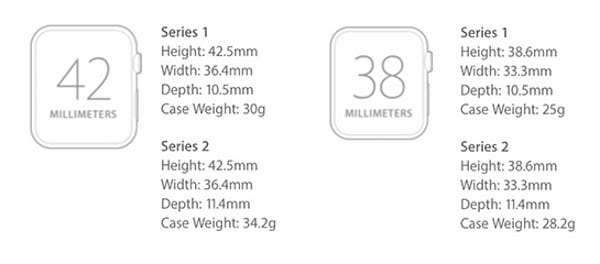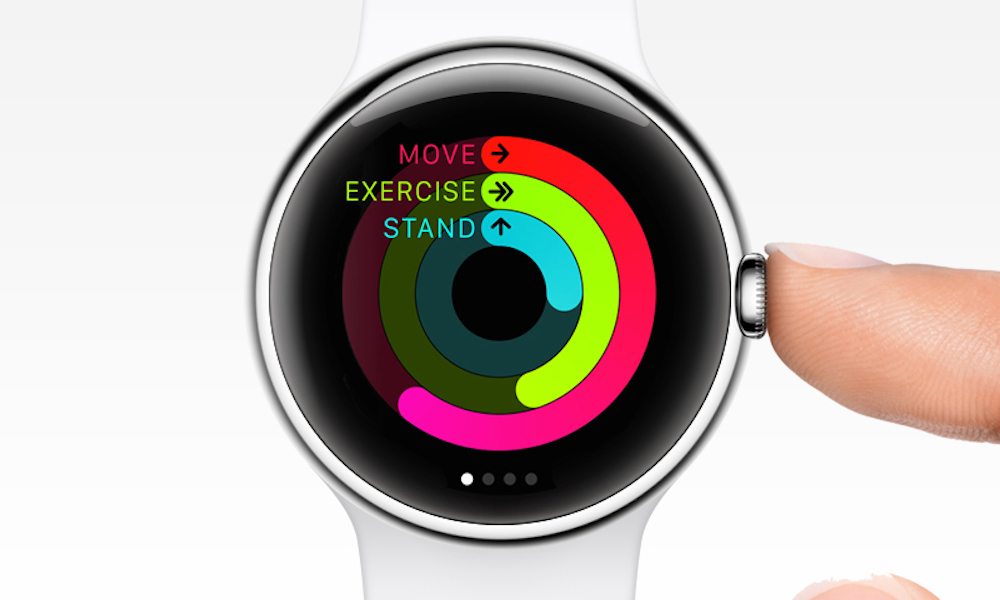Apple Watch Series 3 vs. Series 0/1/2 Thickness Comparison
Image via Anandtech
Toggle Dark Mode
Since its debut, the Apple Watch’s overall design has remained relatively static. But the wearable’s form factor has changed in a pretty specific way.
Namely, Apple Watches have gotten slightly thicker and heavier since the first model in 2015. Why is this, does it really matter, and where do Apple Watches go from here? Here’s what you need to know.
Apple Watch Thickness Comparison
In the following table, you can see the weight and thickness of each Apple Watch model released thus far.
Note: The specifications only apply to Apple Watch models with aluminum cases. The increase in depth and weight are seen across different case materials, but stainless steel and ceramic cases are a bit heavier by default.
Apple Watch Model |
Thickness (Depth) |
Weight |
|---|---|---|
| Apple Watch Series 0 38mm | 10.5 mm | 25g |
| Apple Watch Series 0 42mm | 10.5 mm | 30g |
| Apple Watch Series 1 38mm | 10.5 mm | 25g |
| Apple Watch Series 1 42mm | 10.5 mm | 30g |
| Apple Watch Series 2 38mm | 11.4 mm | 28.2g |
| Apple Watch Series 2 42mm | 11.4 mm | 34.2g |
| Apple Watch Series 3 GPS 38mm | 11.4 mm | 26.7g |
| Apple Watch Series 3 GPS 42mm | 11.4 mm | 32.3g |
| Apple Watch Series 3 LTE 38mm | 11.4 mm | 28.7g |
| Apple Watch Series 3 LTE 42mm | 11.4 mm | 34.9g |
Image via Matt Hauger
As you can see, the Apple Watch Series 0 (first generation) and the Apple Watch Series 1 are pretty much identical in terms of size and weight.
The Apple Watch Series 2 is slightly heavier. Surprisingly, the 38mm Apple Watch Series 3 GPS model is actually a bit lighter than the 38mm Apple Watch Series 2.
It’s also worth noting that the size and weight differences are pretty minimal. Most people probably wouldn’t even notice that later models are thicker and heavier unless they did a direct comparison between the two in-person.
Why Are Apple Watches Getting Thicker & Heavier?
To be clear, we don’t have an official answer from Apple as to why its flagship wearables have been getting thicker. Based on their capabilities, however, we can make a few assumptions.
The first Apple Watch, which is the thinnest and lightest, was pretty basic. It lacked baked-in GPS or cellular functionality and relied on an iPhone for all of its connectivity.
The subsequent Apple Watch Series 1 was similarly sized and has a similarly limited feature set.
Later models changed this, of course. The Apple Watch Series 2, released in 2016, sported built-in GPS functionality.
Image via Apple
The Apple Watch Series 3, released last year, added cellular capabilities for some models.
These additional functions obviously require additional physical components. But there’s also another factor at play: battery life. Adding GPS and cellular connectivity demands more battery life. In turn, that requires a bigger battery.
That’s likely the chief reason why the only size difference among Apple Watch models was between the Series 0/Series 1 and the Series 2/Series 3.
Image via Gigazine
The Series 2 and Series 3 have the same relative case depth (thickness). But subsequent generations have gotten slightly heavier, with GPS + Cellular Series 3 models coming in at the heaviest.
As we mentioned earlier, the only notable exception is the 38mm Apple Watch Series 2 with aluminum case. It’s actually slightly lighter than the previous comparable generation.
Apple Watch Thickness: Does It Really Matter?
It’s probably safe to say that most Apple Watch owners love their device. But, of course, even those who do love the flagship wearable may have some complaints.
If you Google “Apple Watch thick,” you’ll find a scattering of social media and blog posts complaining about the thickness of the wearable and how it’s a problem. On the flip side, it’s pretty much impossible to figure out how many people are actually perfectly fine with the Apple Watch’s size. People take to the internet to complain more than praise, generally.
Image via The Verge
To be fair, a good chunk of actual analog watches are pretty thick, too. And since the Apple Watch is the best-selling watch in the world, we can assume that its perceived thickness hasn’t really been that much of an issue.
In other words, some people may find the Apple Watch too thick. But it’s necessarily not a widespread complaint about the device — and it hasn’t stopped people from buying it.
What Will Future Apple Watches Look Like?
Renowned KGI Securities analyst Ming-Chi Kuo has forecasted that the Apple Watch Series 4 could sport a slightly larger battery and display. Unless Apple makes internal tweaks, these features might need a slightly larger case size.
But it’s doubtful that Apple will make the Apple Watch Series 4 significantly thicker. The company obviously wants its devices to remain practical and wearable.
Image via Watchaware
Similarly, Kuo has stated that the Apple Watch Series 4 could have a design that is “more trendy.” That is, of course, extremely vague. But it suggests that the Apple Watch could see its first form factor update since it launched.
If the Apple Watch S4 is slightly wider but thinner, for example, it might offset the bump in depth.
But it’s possible that Apple could switch up the form factor pretty drastically in a way we aren’t expecting. Depending on Apple’s design magic, that could also mitigate the need for larger cases.
The Apple Watch Series 4 is largely expected to debut in the fall at Apple’s annual keynote.
Learn More: 40+ Fantastic Things You Can Do with an Apple Watch Series 3











